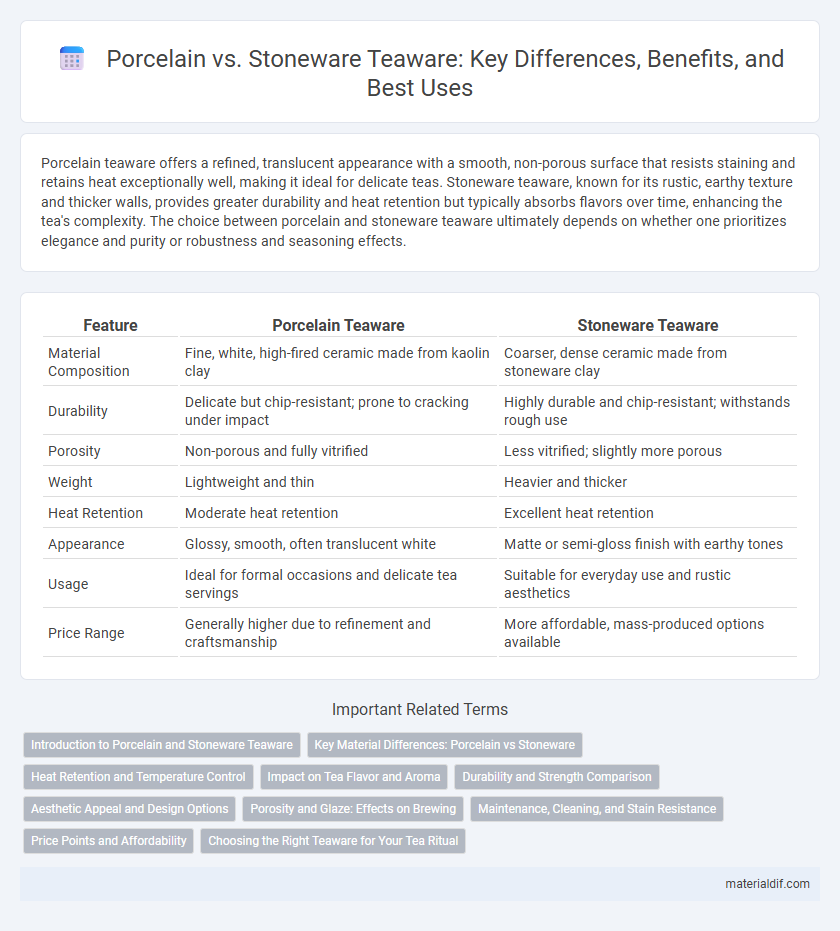Porcelain teaware offers a refined, translucent appearance with a smooth, non-porous surface that resists staining and retains heat exceptionally well, making it ideal for delicate teas. Stoneware teaware, known for its rustic, earthy texture and thicker walls, provides greater durability and heat retention but typically absorbs flavors over time, enhancing the tea's complexity. The choice between porcelain and stoneware teaware ultimately depends on whether one prioritizes elegance and purity or robustness and seasoning effects.
Table of Comparison
| Feature | Porcelain Teaware | Stoneware Teaware |
|---|---|---|
| Material Composition | Fine, white, high-fired ceramic made from kaolin clay | Coarser, dense ceramic made from stoneware clay |
| Durability | Delicate but chip-resistant; prone to cracking under impact | Highly durable and chip-resistant; withstands rough use |
| Porosity | Non-porous and fully vitrified | Less vitrified; slightly more porous |
| Weight | Lightweight and thin | Heavier and thicker |
| Heat Retention | Moderate heat retention | Excellent heat retention |
| Appearance | Glossy, smooth, often translucent white | Matte or semi-gloss finish with earthy tones |
| Usage | Ideal for formal occasions and delicate tea servings | Suitable for everyday use and rustic aesthetics |
| Price Range | Generally higher due to refinement and craftsmanship | More affordable, mass-produced options available |
Introduction to Porcelain and Stoneware Teaware
Porcelain teaware is crafted from refined clay fired at high temperatures, resulting in a smooth, translucent, and durable surface ideal for elegant tea presentation. Stoneware teaware, made from denser clay and fired at slightly lower temperatures, offers a robust, opaque finish with excellent heat retention properties suitable for everyday use. Both materials provide unique tactile experiences and thermal characteristics, influencing flavor perception and tea cooling rates.
Key Material Differences: Porcelain vs Stoneware
Porcelain teaware is crafted from refined kaolin clay fired at higher temperatures around 1,200-1,400degC, resulting in a glassy, translucent surface that is non-porous and highly durable. Stoneware teaware uses a denser clay body fired at lower temperatures, typically between 1,100-1,300degC, producing a more opaque, heavier material with a slightly porous texture. These key material differences influence porcelain's delicate appearance and heat retention, while stoneware offers robustness and a rustic aesthetic ideal for everyday use.
Heat Retention and Temperature Control
Porcelain teaware offers superior heat retention due to its dense and non-porous structure, maintaining beverage temperature longer than stoneware. Stoneware teaware provides better temperature control with gradual heat dissipation, ideal for brewing delicate teas that require specific temperature ranges. The thermal properties of porcelain make it ideal for keeping tea hot, while stoneware's porous composition enhances flavor extraction through controlled cooling.
Impact on Tea Flavor and Aroma
Porcelain teaware preserves the delicate flavors and aromas of tea due to its non-porous, smooth surface, which does not absorb any tea oils or residues. Stoneware teaware, being porous and heavier, can retain flavors from previous brews, subtly altering the taste profile and aroma of subsequent cups. For tea enthusiasts seeking a pure, clean tasting experience, porcelain offers superior flavor clarity, while stoneware may enhance complexity over time through seasoning.
Durability and Strength Comparison
Porcelain teaware exhibits higher durability and strength compared to stoneware due to its denser composition and higher firing temperature, which results in a non-porous, chip-resistant surface. Stoneware is more prone to chipping and cracking under thermal shock because of its coarser texture and lower firing temperature. The superior hardness and resistance to staining make porcelain a more long-lasting and reliable choice for everyday use.
Aesthetic Appeal and Design Options
Porcelain teaware offers a refined, translucent appearance with smooth, glossy surfaces that highlight intricate patterns and vibrant colors, appealing to those seeking elegance and sophistication. Stoneware teaware features a more rustic, earthy aesthetic with matte finishes and natural textures, often showcasing hand-crafted designs suited for a casual or artisanal feel. Porcelain's ability to be finely molded enables detailed, delicate shapes, while stoneware's durability supports robust, organic forms, providing diverse design options for different tastes and settings.
Porosity and Glaze: Effects on Brewing
Porcelain teaware features low porosity and a smooth, glass-like glaze that prevents absorption of flavors and moisture, ensuring a pure taste during brewing. Stoneware teaware, with higher porosity and a less uniform glaze, can absorb tea oils and water, subtly influencing the flavor over time. The non-porous nature of porcelain enhances heat retention and durability, making it ideal for consistent and clean tea extraction.
Maintenance, Cleaning, and Stain Resistance
Porcelain teaware offers superior stain resistance due to its non-porous, vitrified surface, making it easier to maintain and clean compared to stoneware. Stoneware's porous composition can absorb liquids and stains, requiring more frequent and careful cleaning to prevent discoloration and odor retention. Regular gentle washing with mild detergent preserves the finish of both materials, but porcelain's dense glaze enhances durability and stain resistance over time.
Price Points and Affordability
Porcelain teaware generally commands higher price points due to its fine craftsmanship, translucency, and durability compared to stoneware teaware. Stoneware offers a more affordable option with thicker, heavier construction and rustic appeal, making it suitable for everyday use without the premium cost associated with porcelain. Consumers seeking luxury and delicate aesthetics often invest in porcelain, while those prioritizing budget and sturdiness lean towards stoneware teaware.
Choosing the Right Teaware for Your Tea Ritual
Porcelain teaware offers a refined, non-porous surface that preserves the delicate flavors and aromas of fine teas, making it ideal for green and white teas. Stoneware teaware, known for its heat retention and earthy texture, enhances the richness of black and oolong teas by allowing gradual heat release. Selecting the right teaware depends on your preferred tea type and brewing style, ensuring optimal flavor extraction and a satisfying tea ritual experience.
Porcelain Teaware vs Stoneware Teaware Infographic

 materialdif.com
materialdif.com